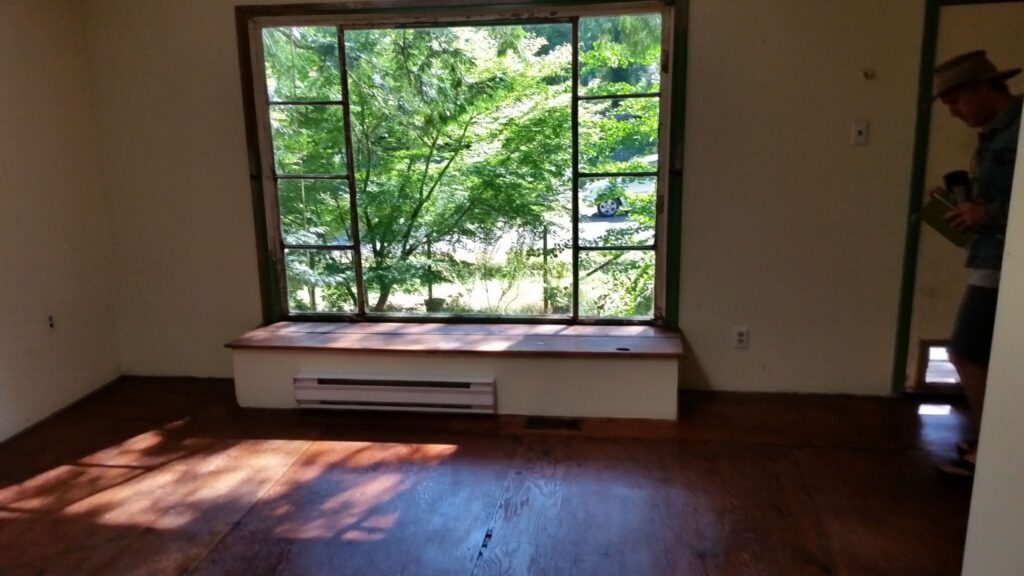- Photo: House showing its age.
- Abstract: Bowen Island Home Inspector discusses renovation issues.
Renovation Opportunities
Some of the best opportunities in real estate are when the assessed value of a house is only 10% to 20% of the total property’s assessed value. Another way of stating this is that, there is opportunity when 80% to 90% of the assessed value is in the lot.
For affluent buyers, this type of house is considered a tear down.
For buyers who are entering this inflated market with limited funds, the house can still be considered a home. Obviously some sweat equity and capital may be needed. In some cases these houses have been neglected, vacant or vandalized. As a result, the degree of rehab will vary.
So what should a buyer look for in this type of ‘discounted’ house? In general, there are four house systems that require close scrutiny and should give a good overview of building’s condition:
- Roof
- Plumbing
- Heating
- Electrical
Building Envelope
ROOF condition will determine if the house has been adequately protected from the weather. In particular, has the roof been an adequate protective envelope from water ingress? Water penetration and the associated conditions of rot and mold are greatest enemy of wood frame construction. Keep the wood dry and you have a reasonable chance of having a sound structure. The roof shingles can and do degrade over time. An asphalt shingle roof will need replacement in 20-30 years. But the most important aspect of the roof can only be viewed by inspecting the attic cavity. There, the condition of the sub-roof or sheathing, the rafters or trusses and the through-ceiling and through-roof penetrations reveal how well each of these components have performed, or not. For an attic the greatest enemy is moisture build-up for lack of adequate ventilation. Poor ventilation will lead to wood rot. A roof and attic with multiple problems of water leaks and the effects of decades of moisture build-up may make this building system costly to repair or replace.
Potable & Waste Water Piping
PLUMBING standards in the 1960’s included galvanized water supply lines, cast iron waste water piping and copper distribution lines. By now, all of the above piping material would be well beyond their life expectancies. If the house still has these original components, then expect a hefty plumbing bill to replace them all. There is no option of procrastination, as failure is imminent. If these materials have been replaced by cross-linked polyethylene (PEX) water distribution piping and black plastic ABS for waste piping, then the plumbing has been upgraded some time in the past and consider yourself fortunate indeed!
Mechanical System
HEATING has evolved tremendously over time as have the insulation standards. A natural gas furnace has had three generations of technological improvements over this period of time. If the house has a first generation gas furnace, then a replacement is definitely in order. On the other hand, baseboard heaters have changed very little over that same period of time. An airtight wood stove from that era is most certainly worn out and grossly inefficient compared to today’s airtights with secondary heat exchangers. Remember that a 1960’s house was built with 2×4 stud walls and at most the insulation or R value will likely be around 10, which is less than half to one third of what can be expected in a newer house. In addition, energy costs were not an issue in that era. So investing in a modern wood burning appliance as the primary source of heating makes a lot of sense, if your municipality allows it.
Power Distribution
ELECTRICAL systems were in transition during the 1960’s. Fuse boxes were changing over to breaker panels. Two prong wall receptacles were replaced by the three wire grounded receptacles. In some cases, ungrounded 2-wire distribution was used well until the end of the 60’s and even into the early 70’s. Ground fault circuit interrupters (GFCI), smoke alarms and carbon monoxide detectors were unheard of in that decade. The main service supply of 60 Amps was considered adequate for the time. Whereas now, a similarly sized house would have a minimum 100 Amp service. Be sure to check main supply ampacity, whether you have breakers or fuses and if the wiring is 2 or 3 prong. If the electrical system has not been upgraded, then for occupant safety and convenience, be prepared to do so as soon as possible.
Worth Renovating?
In conclusion, with the above four house systems assessed, a reasonable determination can now be made if the house is worth renovating. Keep in mind that even if you intend to renovate, decide if it has to last for another 2 years or 10 years… that decision will significantly affect your renovation scope and by extension, the budget.

